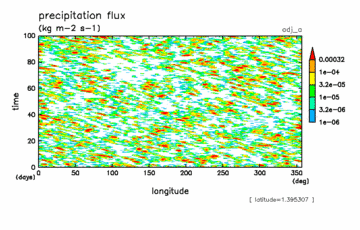
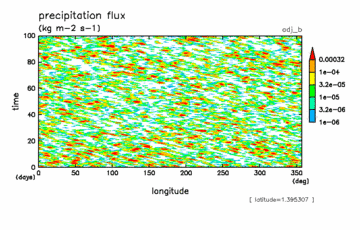


| 4. Results with moist convective adjustment scheme | [prev] [index] [next] |
In this subsection, we examine sensitivity of longitudinal-temporal variation of precipitation along the equator to the vertical profile of radiative cooling for the experiment with moist convective adjustment scheme. We show the enhanced wavenumber-frequency power spectra of north-south symmetric component which are produced following Wheeler and Kiladis (1999) (See Appendix B.2 for the brief description of the calculation procedure).
Fig.4.4 show time-longitude cross sections of precipitation along the equator. It is recognized that, for all cases, precipitation takes in a form of events which appear for a duration of the order of a day with a small horizontal scale near the limit of spatial resolution. In the same way as the cases with Kuo scheme of previous section (subsection 3.2) These events are referred to as grid-scale precipitation activity or events. Compared to the cases with Kuo scheme, however, those with adjustment schem appear rather randomly, except for case adj-d, where the upper level cooling is most intense, and we can recognize a series of seaquences of eastward propagating convective activity like those of casees kuo-c and kuo-d.
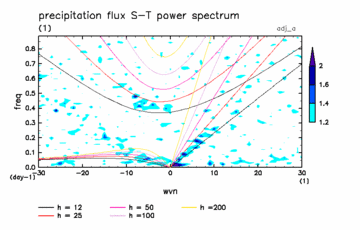
|
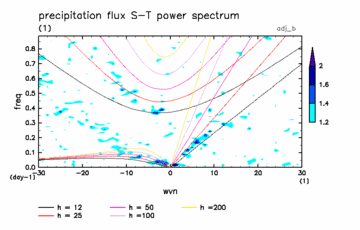
|
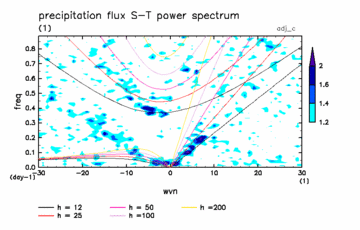
|
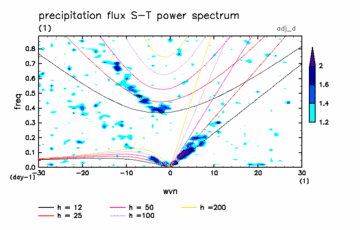
|
| Fig.4.5: Wavenumber-frequency power spectra of north-south symmetric component of precipitation around the equator of the experimnt with moist adjustment scheme. (upper left) adj-a, (upper right) adj-b, (lower left) adj-c, (lower right) adj-d. Data are the same as for Fig.4.4. Unit is non-dimensional, since enhance technique by Wheeler and Kiladis (1999) is utilized (See Appendix B.2 for the description of calculation). Lines represent the dispersion relations of equatorial waves with odd longitudinal indices. Labels represent values of equivalent depths for corresponding lines, which are 12, 25, 50, 100, and 200 [m], respectively. | |
Fig.4.5 shows wavenumber-frequency power spectra of equatorially symmetric component of precipitation around the equator. It is indicated that, contrary to the appearance of precipitation activity in the real space shown in Fig.4.4, characteristics like those observed for the experiment with Kuo scheme are clearly identified. Namely, for all of the cases, there exist e eastward propagating signals that are located on the dispersion relation of Kelvin waves, westward propagating low wavenumber signals that are located around the dispersion relation of Rossby waves, westward propagating high wavenumber non-dispersive signals, and high frequency signals that are located in the region of inertio-gravity waves.
Comparing four cases with adjustment scheme, the intensity of the eastward propagating signals located on the dispersion relation of Kelvin waves is weaker for cases adj_a and adj_b where the radiative cooling in the upper atmosphere is weak, compared to that of cases adj_c and adj_d where the radiative cooling in the upper atmosphere is strong. This tendency is the same as that of the experiment with Kuo scheme.
The propagation speed of non-dispersive high wavenumber westward signals is larger than zonal mean easterly speed at the lower level of the atmosphere; for instance, the westward speed is about 7.5 [m s-1] for case adj-c compared to about 5 [m s-2] of the easterly wind speed. This is contrary to the result for cases with Kuo scheme. The reason of this difference is yet to be clarified.
The equivalent depth that explains the phase speeds of equatorial waves corresponding to the precipitation signals is about 20 [m], which is even smaller than that for the experiment with Kuo scheme (subsection 3.2). This suggests that, as discussed for the experiment with Kuo scheme, there are interactions between waves and condensation heating in those disturbances associated with precipitation.
| [prev] [index] [next] |